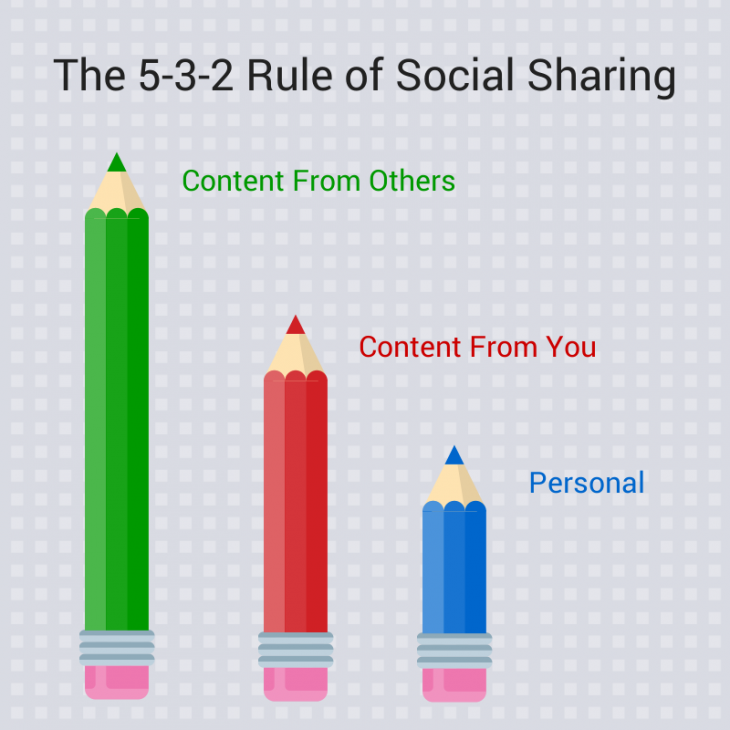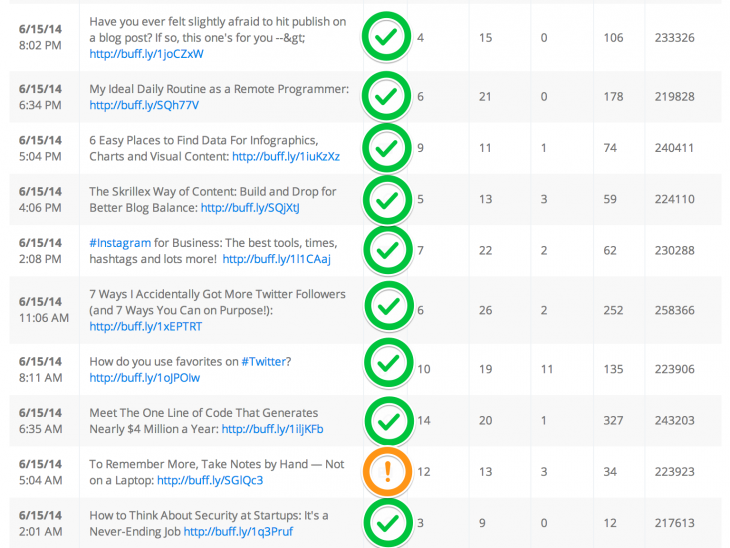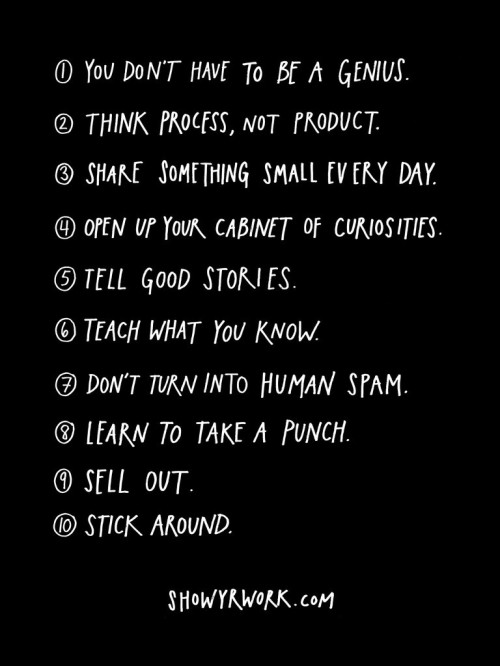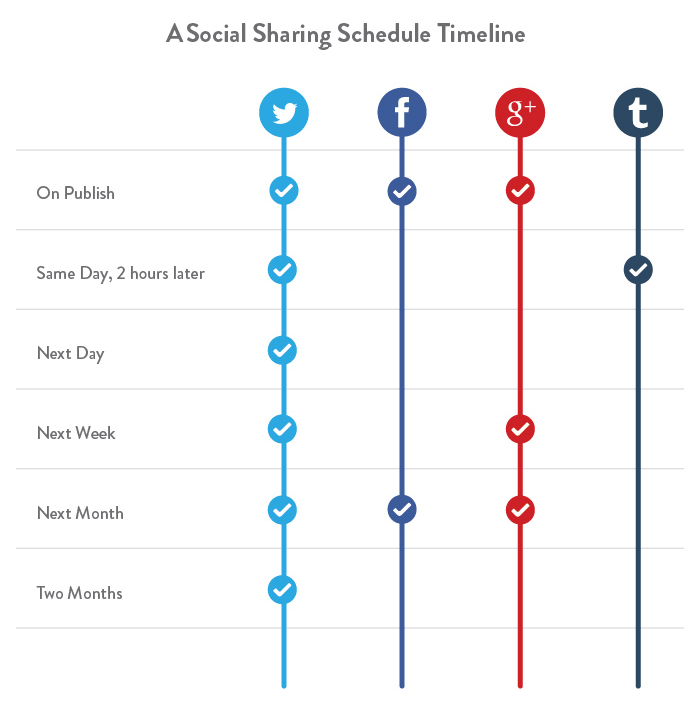
This post originally appeared on the Buffer blog.
If you’ve been to any of Buffer’s social media accounts recently (take Twitter, for instance), you may have noticed that the lion’s share of stories we share come from us. We tweet our own stuff. We toot our own horn.
It would certainly seem that we are in the minority with this strategy. There seems to be a a fine line between sharing enough of your own stuff and sharing too much. Most people would rather err on the side of just enough (or even less) in their social media strategy.
We all want to see our content read and shared widely, but no one wants to look like an attention hog. How much self-promotion is too much self-promotion? It’s a great question. Here are some thoughts.
6 popular ratios for sharing content on social media
There are quite a few methods out there for choosing what to share. Most of these methods skew heavily toward sharing content you curate from other sites and sprinkling in your own stuff here and there. Here are 6 popular ratios.
5-3-2
Introduced by TA McCann from Gist.com, the 5-3-2 rule of social media sharing aims for a blend of your content, others’s content, and personal updates. Note that the 5-3-2 is not a daily quota but rather a ratio for any group of 10 updates you post over any timeframe (same goes for the rest of these ratios, too).
- 5 should be content from others
- 3 should be content from you
- 2 should be personal status updates
4-1-1
Much like the 5-3-2 rule, the 4-1-1 Rule seeks a good ratio of content from others, content from you, and reshares. Popularized by Andrew Davis of Tippingpoint Labs and Joe Pulizzi of Content Marketing Institute, the 4-1-1 looks like this in practice:
- 4 pieces of relevant, original content from others
- 1 retweet for every 1 self-serving update
555+
Shai Coggins of Vervely has a somewhat unique approach to a balanced sharing schedule. The 555+ Guideline seeks to add some variety to a timeline and to keep your social media profile from “looking like a pulpit.”
- 5 updates about you and your content
- 5 updates about others
- 5 responses/replies
- + miscellaneous posts that add value like #FollowFriday or user-generated content
Rule of Thirds
Mentioned on the Hootsuite blog by Sam Milbrath, the Rule of Thirds is a perfectly balanced way to split up your social media posts. It works like this:
- 1/3 of your updates are about you and your content
- 1/3 of your updates are for sharing content from others and surfacing ideas
- 1/3 of your updates are based on personal interactions that build your brand
Golden Ratio – 30/60/10
The Golden Ratio from Rallyverse covers similar ground as the 5-3-2 rule, albeit with a couple small tweaks to the percentages and the content. Here’s how Rallyverse proposes an ideal sharing ratio:
- 30 percent owned
- 60 percent curated
- 10 percent promotional
The 20-to-1 rule
This ratio by Michael Hyatt varies a bit from the ratios above in that it is not a strictly, cut-and-dry social media formula. The ratio has a lot to do with the way you update but moreso with the type of message you’re sending with your posts. Here’s how Hyatt explains things:
This phenomenon is what I have come to call the 20-to-1 rule. It represents a ratio. It means that you have to make 20 relational deposits for every marketing withdrawal. This isn’t science. I don’t have any hard, empirical evidence to prove it.
Buffer’s ratio for sharing content on social media
In the above examples, the scales are tipped quite heavily in favor of sharing content from others. Our ratio at Buffer is going to seem quite contrary.
Our social media updates are 90 percent our own content and 10 percent from others, and many days those numbers are even more lopsided.
Take Sunday, for instance. Here is a breakdown of a group of 10 updates we posted to our Twitter account. Green check marks are our own content. The orange exclamation point is content from others.
This selection of updates has a 90:10 ratio of our content compared to others’s content. Had I grabbed 10 updates from Monday, all 10 might have been Buffer content.
Clearly, we lean heavily toward sharing our own stuff.
Though we’re in the minority with our sharing ratio, we’re not alone. Some of the world’s best players in content share nearly exclusively from their own archives, blog, and marketing. Looking at the most recent 10 posts from Moz on Twitter, all 10 of them are Moz content. The most recent 10 posts from Brain Pickings are all links back to the Brain Pickings blog.
How to turn down a marriage proposal like Charlotte Brontë http://t.co/RcZA5neoDS pic.twitter.com/Jqok2Q6cJk
— Brain Pickings (@brainpickings) June 19, 2014
So what is it about us outliers? What do we see that others don’t?
Self-promotion can work when you add value and engage
Self-promotion has a bad reputation because it is so often associated with marketing, advertising, and social timelines that do nothing but pitch, pitch, pitch regardless of how it makes their audience feel. No wonder the term “self-promotion” makes you fidget in your seat.
We’ve been trained to think of it in a certain way. Well, can I let you in on a secret? You can be self-promotional and still provide value.
Self-promotion can be a good thing if your content is outstandingly useful and always adds value. This is how we think of our social sharing at Buffer. If we share the best content we have and do so in a helpful, actionable, high-utility way, we believe we are doing right by our audience. Value takes a front seat, and self-promotion sits in the back.
Both elements are there, but the high value of outstanding content is what matters most. Since we post up to 14 times per day on Twitter, filling those posts with our own content—and ensuring that the content stays outstanding and helpful—requires a deep pool of posts.
We are fortunate to have deep archives of evergreen content to pull from on the Buffer blog; we can grab stories that were originally written more than a year ago that still have application today.
So reason number one why we toot our own horn: Providing value.
Reason number two: We value transparency and sharing our work.
Austin Kleon wrote a book, Show Your Work!, about this very concept of being self-promotional without being a turnoff. He calls it a book for people who hate the idea of self-promotion. Here’s the outline for what the book covers. Take note of points three, four, and six.
“Tell good stories” is akin to sharing outstanding content. “Open up your cabinet of curiosities” and “share something small every day” equate to the notion of transparency, camaraderie, and community.
At Buffer, we feel that sharing our own content on social media is a way to reveal more about us, to show and share our work. Much of our content has a “let’s learn this together” feel, and we’re never shy about sharing our process, warts and all.
The third reason we feel comfortable with our 90/10 split for content sharing is that sharing content is only a piece of our social media strategy. We are also on social media to engage. Sharing content is a broadcast; engaging the community is a conversation.
We’ve found that having both parts to our social presence makes self-promotion all the more powerful. We can share our own content, and our followers know we are still there listening, replying, and engaging.
Our Happiness Heroes reply to nearly every tweet that comes our way, including the conversations that happen with our self-promotion/broadcast content. Here’s a recent reply thread from something we shared.
@PrintcessGinny Ah shucks, thanks Ginny! Feels like the Brady Bunch to me.  -Mary — Buffer (@buffer) June 19, 2014
-Mary — Buffer (@buffer) June 19, 2014
Also, we’ve started up a weekly series of Twitter chats (the next one is Wednesday, if you’d like to join). These #bufferchats give us yet another opportunity to engage directly with followers and fans.
We’ve found that engagement and sharing go hand-in-hand in a smart automation strategy, even—or maybe especially—a strategy that is as self-promotional as ours.
Baby steps – Start with something small
If you’re interested in getting more comfortable with self-promotion but aren’t quite sure you want to jump all the way to 90/10 like us, you can take baby steps. Start by sharing the same piece of content more than once. We’ve written before that reposting content multiple times can lead to double the engagement. Reposting helps reach your audience in different time zones and new followers who might have missed the post its first time around.
Garrett Moon of CoSchedule put together a really sharp graphic for showing how you might schedule this reposting of content. Feel free to start with this template, test your results, and iterate from there.
Recap
A recent customer survey found that pushing a sale through self-promotion can drop consumer trust by nearly 50 percent. Stats like this are one reason why folks are scared to try self-promotion.
But can you spot the key phrase in that stat? “Pushing a sale.” Not all self-promotion needs to be sales-oriented. The best kinds are quite the opposite.
From our perspective, it feels that the problem most of the time isn’t self-promotion, it’s self-promotion of content that isn’t adding value. If your content is intriguing and useful, chances are it will be welcomed by readers—no matter your sharing ratio.
It’s about showing your work. It’s about adding value. And in the midst of sharing your own content, stay engaged with those you’re there to serve.
What is your take on the idea of self-promotion on social media? What ratio do you aim for with your social sharing? It’d be awesome to hear from you in the comments.
Get the TNW newsletter
Get the most important tech news in your inbox each week.










